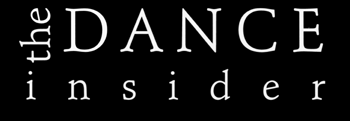|
|
the
New York manufacturer of fine dance apparel for women and girls.
Click here to see a sample of our products and a
list of web sites for purchasing.
With Body Wrappers it's always performance at its best.
|
Go back to Flash Reviews
Go Home
Flash
Review 2, 11-19: Etch A Sketch in Streamlined Indigo
Forsythe's "Ricercar" = One Confused Room
By Rosa Mei
Copyright 2003 Rosa Mei
FRANKFURT -- No one
could accuse William Forsythe of being simple. Even his detractors
don't often question his curiosity. Most just seem to object the
110-decibel screechings in his work or find his blatantly obtuse
theorizing -- eidos/telos, et al -- annoying. A movement linguist
at heart, Forsythe plays with dance syntax and microaesthetic locomotion
to the nth degree. No small surprise he's a fan of "Finnegan's Wake,"
by James Joyce. "Finnegan's Wake" in a nutshell? A paranoiac search
for meaning and encyclopedic phantasmagoria of signifiers in the
post-modern age. You could pretty much say the same thing about
"Ricercar," Forsythe's new 17-minute paradoxical bundle, which premiered
last week at Frankfurt's Opernhaus am Willy-Brandt-Platz. A compendium
of 20th-century dance -- a little Mr. B neoclassicism here, a little
Pina pedestrian gesture there, with some yoga poses thrown in for
good measure -- "Ricercar," seen Saturday, is a bit scattered and
incoherent. But simple? Definitely not.
Ricercar, from Merriam-Webster:
any of various keyboard musical forms of the 16th and 17th centuries
in either quasi-improvisatory toccata style or strict polyphonic
fugal style.
Ricercar, from the Italian
word ricercare: to seek again, seek out.
"Ricercar," as defined
by William Forsythe, 2003: a formal investigation, two couples (man/woman,
man/woman) in indigo ballet 'tards pretzeling arms to Bach's plunky
"Varationen uber Ricercar a 6'," played, in Saturday's performance,
by David Morrow on a grand piano downstage left. The dancers squeegee
their limbs across imaginary planes and make double jointed meandering
look like a walk in the park. Plyometric pyrotechnics a la Forsythe.
The piece begins with
formal ballet counterpoint, clean Cechetti lines, textbook 4th positions
and attitude turns. The formalism, enhanced by the dancers' finely
tapered limbs and prehensile feet, quickly dissolves into pigeon-toed
skitters across the stage. Allison Brown's legs ricochet off Fabrice
Mazliah's forearm to initiate a complex coiling pattern. Dana Caspersen
assumes various yoga poses and sickles her feet while Christopher
Roman does etch-a-sketch with his head, shoulder, elbows and hips.
Their bodies converge and diverge in intervals, negotiating nodes
in space.
These two dancers showcase
Forsythian prowess with a special sort of elan. Caspersen, that
spitfire wonder, carves three-dimensional space like buttah. An
uber-technician with fast-twitch muscle to burn, she's small and
power-packed. And with that ooh lah lah ooze seeping from her pores,
you see why she's a star. Roman, another diamond dancer, has that
quicksilver clarity that Forsythe shows in his own dancing. Hyper-articulate
and fleet of foot, Roman pulls his opposing body parts like taffy,
while leaving crisp afterimages of hip swizzles and elbow doodles.
It's the kind of pristine precision you can't train; some folks
just have the gene.
Unfortunately, in "Ricercar,"
Forsythe's intricate movement combinations (the u-lines, o-transformative
operations, reverse temporal orders and adjectival modifications
of spacial recovery*...phew!) almost overpower the overarching architecture
of the piece. "Ricercar" displays the choreographer's genius for
endless movement invention, but somehow, on a macroscopic level,
his chunks of visual information seem haphazardly glued together.
A dash of Mr. B (think "Agon" redux), some Pina shoulder shrugs, plus some
sickle-footed non-sequiturs for flavor. The piece as a whole seems
to lack the through line that so often defines the movement phrases
themselves. Seems odd, since Forsythe is someone obsessed with structure;
yet here, he doesn't balance his micro and macro. In "Ricercar,"
Forsythe comes across as a master mangler of body parts but only
an adept architect.
A similarly structured
piece, last year's "The Room as It Was," seen on this same program
and reviewed here previously by my colleague Gus Solomons jr, has a certain
improvised magic that "Ricercar" lacks. The dancers in rehearsal
clothes and the workshop feel of "The Room" highlight Forsythe's
open-ended structure. We can focus on the endless coiling, the clever
slicing and dicing of space. Maybe "Ricercar" would read better
without the foil wrapping -- the chignons, the indigo ballet wear
and grand piano. It's like everyone got duded up to go to Chez Panisse
and the local greasy spoon both on the same night.
But perhaps this isn't
Forsythe's concern. In a 1999 interview with Nik Haffner*, Forsythe
described his creative process as follows: "At any given moment
you have to be able to say : What is the potential of this configuration
of my body. And at one point, I guess a long way down the line,
you know intuitively what it is. And then I would suggest you try
the results of that which you don't know, move from there, with
no idea how it's going to turn out. For me, that would be a truly
successful dance, because then the body would take over and dance
at that point where you had no more idea. I see that as an idealized
form of dancing; just not knowing and letting the body dance you
around." Signifiers in a postmodern age, indeed.
*From "William Forsythe Improvisation Technologies: A Tool for the
Analytical Dance Eye." (A must-have CD-ROM for all dancers, choreographers
and Forsythe fans -- for more information, click here.)
Go back to Flash Reviews
Go Home
|


